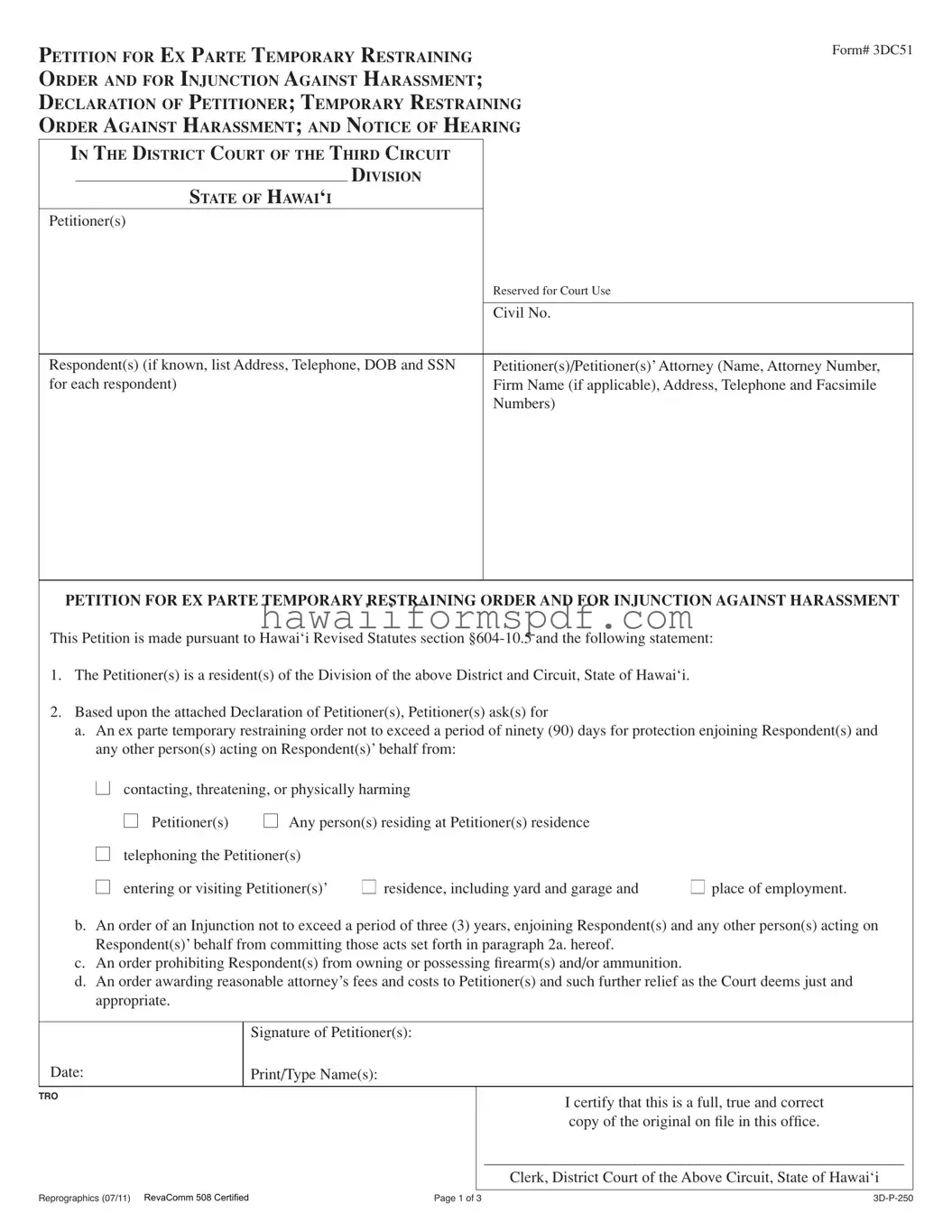
page 2 of 3
DECLARATION OF PETITIONER(S)
Petitioner(s) states the following is true:
q |
Recent or past act(s) of harassment occurred; and/or |
q |
Threats of harassment make it probable that acts of harassment may occur soon. |
Respondent(s) |
q own; |
# |
q possess, or |
q intend to obtain or possess |
q firearm(s) and or ammunition that may be used to threaten or injure Petitioner(s). |
Describe the firearm(s)/ammunition: ______________________________________________________________________ .
Location of the firearm(s)/ammunition: ____________________________________________________________________ .
Date last seen:________________ .
Street address/specific location where last seen: ___________________________________________________________________ .
(Explain in detail recent or past acts or threats of harassment, using additional sheets, if necessary. Please include dates of events.)
q
 Unless Respondent(s)’ wrongful conduct is stopped or prevented by order of the Court, Petitioner(s) will suffer substantial emotional distress.
Unless Respondent(s)’ wrongful conduct is stopped or prevented by order of the Court, Petitioner(s) will suffer substantial emotional distress.
I have read the Petition and Declaration, know their contents, and verify that the statements contained therein are true to my personal knowledge and belief.
I DECLARE UNDER PENALTY OF PERJURY UNDER THE LAWS OF THE STATE OF HAWAI‘I THAT THE FACTS AND CIRCUMSTANCES STATED IN THE PETITION AND DECLARATION ARE TRUE AND CORRECT.
Signature of Petitioner(s):
Print/Type Name:
Reprographics (07/11) RevaComm 508 Certified |
Page 2 of 3 |
3d-P-250 |

page 3 of 3
TEMPORARY RESTRAINING ORDER AGAINST HARASSMENT
(reserved for Court use only)
Based upon the attached Petition for Ex Parte Temporary Restraining Order and Declaration of Petitioner(s) and pursuant to Hawai‘i Revised Statutes §604-10.5, the Court finds there is probable cause to believe:
q
 Recent or past acts of harassment by Respondent(s) have occurred.
Recent or past acts of harassment by Respondent(s) have occurred.
q
 Threats of harassment by Respondent(s) make it probable that acts of harassment may be imminent against Petitioner(s).
Threats of harassment by Respondent(s) make it probable that acts of harassment may be imminent against Petitioner(s).
It appears to the Court that a Temporary Restraining Order should be granted and is necessary to prevent acts of harassment. Accordingly, IT IS ORDERED that Respondent(s) shall appear before the Judge in the above-entitled proceeding at the date, time and place indicated in the Notice of Hearing below. Pending the hearing on this Petition, Respondent(s) is/are ordered as follows:
TO THE RESPONDENT:
YOU AND ANYONE ACTING ON YOUR BEHALF ARE ORDERED AS FOLLOWS:
q |
Do not contact, threaten, or physically harass Petitioner(s) and q any person(s) residing at Petitioner(s) residence |
q Do not telephone Petitioner(s) |
|
q |
Do not enter or visit Petitioner(s)’ q residence, including yard and garage, and |
q place of employment |
q
 Pursuant to HAWAI‘I REVISED STATUTES §134-7, you shall not possess or control any firearm(s) and/or ammunition for the duration of this Temporary Restraining Order.
Pursuant to HAWAI‘I REVISED STATUTES §134-7, you shall not possess or control any firearm(s) and/or ammunition for the duration of this Temporary Restraining Order.
q
 You shall immediately turn over for safekeeping all firearms and/or ammunition in your possession and control to the Hawai‘i
You shall immediately turn over for safekeeping all firearms and/or ammunition in your possession and control to the Hawai‘i
County Police Department (any District Police Station in Hawai‘i County), for the duration of this Order or any extension thereof.
This Order becomes effective upon its signing and filing and shall remain in effect for fifteen (15) days, unless extended or terminated by the Court.
ANY KNOWING OR INTENTIONAL VIOLATION OF THIS TEMPORARY RESTRAINING ORDER AGAINST HARASSMENT IS A MISDEMEANOR PUNISHABLE BY A JAIL SENTENCE OF UP TO ONE YEAR AND/OR UP TO A $2,000 FINE.
A SENTENCE OF 48 HOURS JAIL FOR A SECOND CONVICTION AND 30 DAYS JAIL FOR ANY SUBSEQUENT CONVICTION(S) IS MANDATORY. [HAWAI‘I REVISED STATUTES §604-10.5, §706-663 AND §706-640].
Judge of the above-entitled Court
NOTICE OF HEARING
TO _________________________________________________________________________
__________________________________________________________________________________________________________________
NOTICE IS GIVEN that the Petitioner(s) above named has/have filed the foregoing Petition for Ex Parte Temporary Restraining Order and for Injunction Against Harassment.
YOU ARE COMMANDED to appear before the Presiding Judge of the above-entitled Court, the District Court of the above Circuit.
at _____________________________________________________________________________________________________________ ,
on ____________________________________________________________________________ , 20 ____ at ______ o’clock ____ .M.
Prior to the scheduled hearing date, you or your attorney may file a written response explaining, justifying, or denying the alleged at or acts of harassment. At the hearing, the parties shall be prepared to testify, call and examine witnesses, present any documents, and give legal or factual reasons why the Injunction should or should not be granted. Each party may be represented by an attorney and shall be prepared to proceed at the hearing. IF YOU OR YOUR ATTORNEY FAIL TO ATTEND AT THE TIME AND PLACE DESIGNATED, AN ORDER
GRANTING PETITION FOR INJUNCTION AGAINST HARASSMENT WILL BE TAKEN AGAINST YOU FOR THE RELIEF DEMANDED IN THE PETITION.
The Court shall receive all evidence that is relevant at the hearing, and may make independent inquiry. If the Court finds by clear and con-
vincing evidence that harassment by Respondent(s) in the form of physical harm, bodily injury, assault, of the threat of imminent physical harm, bodily injury to Petitioner(s) exists, it may enjoin for no more than three years further harassment by Respondent(s). If the court finds by clear and convincing evidence that harassment by Respondent(s) in the form of an intentional or knowing course of conduct directed at Petitioner(s) that seriously alarms or disturbs consistently or continually bothers Petitioner(s) and that serves no legitimate purpose exists, and such course of conduct would cause a reasonable person to suffer emotional distress, the court shall enjoin for no more than three years, further harassment by Respondent(s).
This Order shall not be personally delivered between 10:00 p.m. and 6:00 a.m. on premises not open to the public, unless a judge of the above-entitled Court permits, in writing on this Order, personal delivery during those hours.
Clerk of the above-entitled Court
In accordance with the Americans with Disabilities Act , and other applicable State and Federal laws, if you require an accommodation for your disability when working with a court program, service, or activity please contact the District Court Administration Office at PHONE NO. (808) 961-7424, FAX (808) 961-7411, or TTY (808) 961-7422 at least (10) working days before your preceeding, hearing, or appointment date.
ForallCivilrelatedmatters,pleasecallorvisittheDistrictCourtat:HiloDivision,777KilaueaAvenue,Hilo,Ph.(808)961-7515ウKohalaDivision, 67-5187KamamaluStreet,Kamuela,Ph.(808)443-2030ウKonaDivision,79-1020HaukapilaStreet,Kealakekua,Ph.(808)322-8700.
Reprographics (07/11) RevaComm 508 Certified |
Page 3 of 3 |
3d-P-250 |




 Unless Respondent(s)’ wrongful conduct is stopped or prevented by order of the Court, Petitioner(s) will suffer substantial emotional distress.
Unless Respondent(s)’ wrongful conduct is stopped or prevented by order of the Court, Petitioner(s) will suffer substantial emotional distress.

 Recent or past acts of harassment by Respondent(s) have occurred.
Recent or past acts of harassment by Respondent(s) have occurred.
 Threats of harassment by Respondent(s) make it probable that acts of harassment may be imminent against Petitioner(s).
Threats of harassment by Respondent(s) make it probable that acts of harassment may be imminent against Petitioner(s).
 Pursuant to HAWAI‘I REVISED STATUTES
Pursuant to HAWAI‘I REVISED STATUTES 
 You shall immediately turn over for safekeeping all firearms and/or ammunition in your possession and control to the Hawai‘i
You shall immediately turn over for safekeeping all firearms and/or ammunition in your possession and control to the Hawai‘i